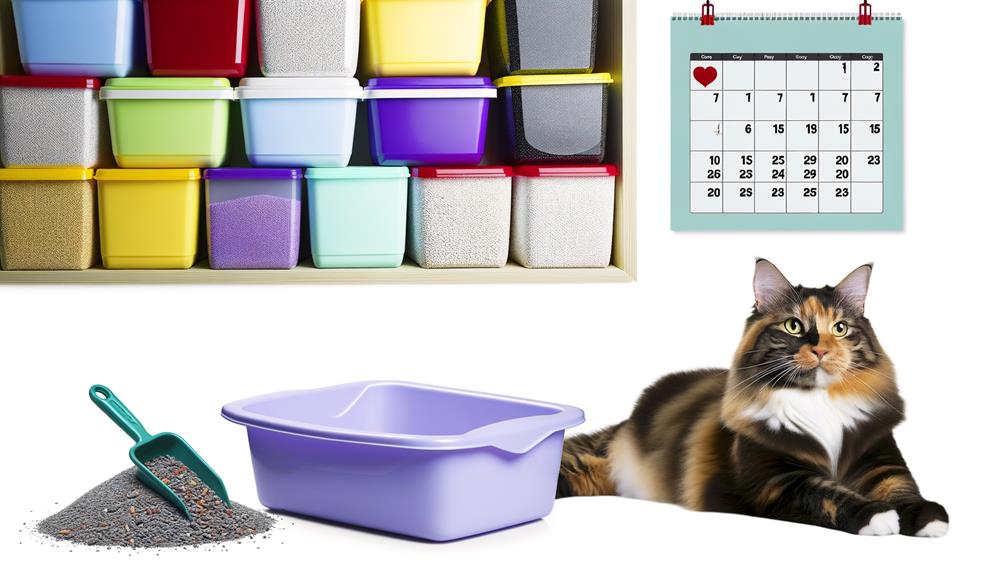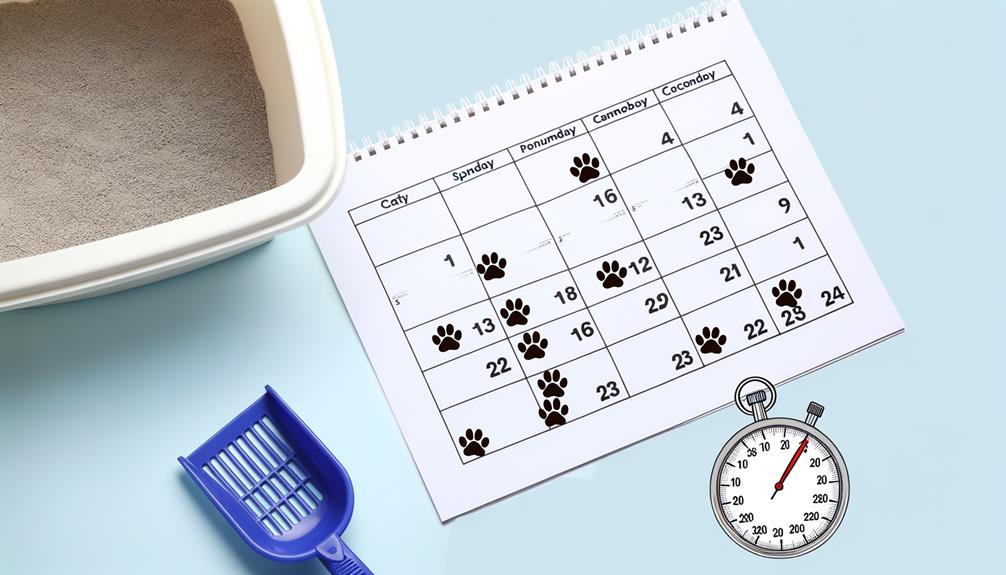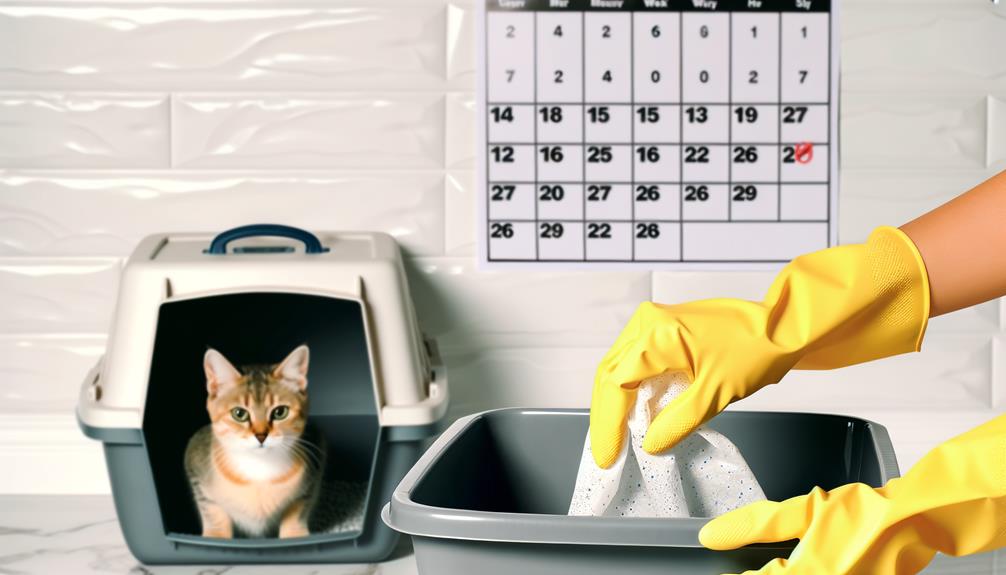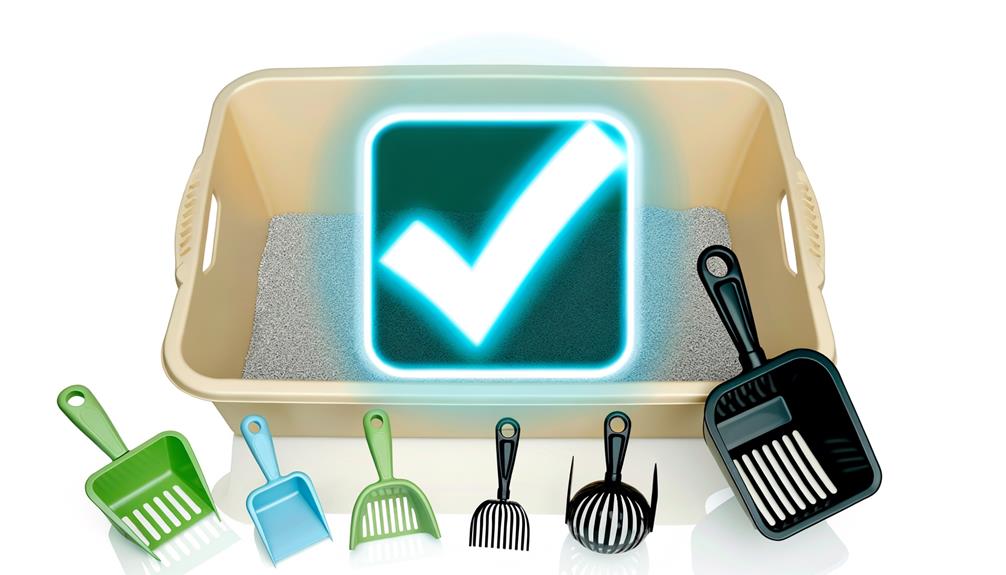As a cat owner, you're likely aware of the importance of a clean litter box, but just how often should it be cleaned? Daily maintenance can keep odors at bay and provide a sanitary environment for your cat. But is that always enough? Depending on your cat's habits, diet, and even their age, the frequency might need to change. Let's discuss this further and explore how the right balance can keep your home fresh and your feline friend happy.
Key Takeaways
- Clean the cat litter box once or twice daily by scooping out soiled litter.
- Adjust cleaning frequency based on your cat's preferences and any behavioral changes.
- Regular cleaning of the litter box is crucial to prevent health risks for both cats and humans.
- A dirty litter box can lead to behavioral issues in cats, including stress and elimination problems.
- Check for signs of potential health issues in your cat while cleaning, such as changes in waste.
Understanding Cat Litter Basics

To keep your cat happy and your home smelling fresh, it's crucial to understand the basics of cat litter. The first thing you need to know is the variety of litter types available, and how your feline friend might respond to each one.
There are primarily five types of cat litter: clay, clumping, silica gel crystals, biodegradable, and self-cleaning. Clay litter is the original and most common type. It's cheap, but it doesn't control odors well and needs frequent changing. Clumping litter, made from bentonite, forms solid clumps when your cat urinates. It's easy to scoop out, but it can create dust that's not great for you or your cat's lungs.
Silica gel crystals absorb urine and control odor well. They're more expensive, but last longer. Biodegradable litter is made from recycled paper, wood, or corn, and is eco-friendly. However, it may not control odors as well as other types. Self-cleaning litter requires a special box. It's convenient but pricey.
Now, let's talk about feline preferences. Cats are creatures of habit and can be finicky about changes, especially to their litter. They prefer unscented litter and might reject anything too perfumed. They also like a litter that's soft on their paws. Most cats prefer clumping litter because it's similar to the sandy soil they'd naturally use.
Importance of Regular Litter Cleaning
Your cat's health and happiness depend heavily on a clean litter box, making regular cleaning a non-negotiable task. If you're thinking, 'Well, it's just cat poop,' think again. There are significant health implications for both you and your feline friend tied to a dirty litter box.
A poorly maintained litter box can harbor harmful bacteria and parasites. These can lead to urinary tract infections, respiratory problems, and other serious health conditions in your cat. For the humans in the house, a dirty litter box can present risks too. For instance, a parasite known as toxoplasma gondii, which can cause toxoplasmosis, can be present in cat feces. So, if you're not cleaning your cat's litter box regularly, you're potentially putting both your health and that of your feline friend at risk.
On top of the health implications, there are substantial behavioral impacts tied to an unkempt litter box. Cats are notoriously clean animals, and a dirty litter box can cause stress and anxiety. This discomfort can lead your cat to start eliminating outside the litter box, a habit that's hard to break once established. It can also lead to more destructive behaviors like scratching and biting.
Determining the Cleaning Frequency

Given the health and behavioral implications of a dirty litter box, it's clear that regular cleaning is a must, but how often should you actually do it? The answer depends on a few factors, including your cat's litter preferences and whether it's showing any behavioral changes.
Your cat's litter preferences play a key role in determining the cleaning frequency. Some cats might be fine with a little mess, while others won't go near the box if it's not pristine. You'll need to observe your cat closely and take note of its preferences. For a cat that's particular about cleanliness, you might need to scoop out waste daily and change the litter completely every week.
Behavioral changes can also be a sign that you're not cleaning the litter box often enough. If your cat starts avoiding the litter box or begins to eliminate elsewhere, it's likely indicating that the box isn't clean to its liking. In such a case, you may need to increase your cleaning frequency.
It's essential to strike a balance that works for both you and your cat. Too frequent cleaning might be time-consuming for you, while too infrequent can lead to an unhappy, uncomfortable cat.
Bear in mind that these are guidelines, not hard and fast rules. Every cat is unique, and what works for one mightn't work for another. The key is to pay attention to your cat's cues and adjust your cleaning schedule accordingly.
Daily Litter Box Maintenance
Maintaining your cat's litter box on a daily basis isn't just about cleanliness, it's essential for its comfort and overall health too. A dirty litter box can lead to behavioral issues and even health problems. Preventing this starts with regular, daily maintenance.
Firstly, you'll need to scoop out soiled litter once or twice per day. Use a slotted scoop designed for this task, and dispose of the waste in a sealed bag. This keeps the box fresh and prevents odors from building up. If you're using clumping litter, make sure you remove both urine clumps and feces.
While scooping, take a moment to check for any signs of health issues. Changes in your cat's waste can indicate problems that might need a vet's attention. Frequent, loose stools or unusually dark urine, for example, are worth noting.
Litter alternatives can be a great option if your cat has allergies or sensitivities to traditional clay litters. These can be made from recycled paper, wood, or even corn. They still need daily scooping, but might be easier on your cat's lungs and paws.
Box placement is also key to keeping the litter box clean and appealing to your cat. It should be in a quiet, low-traffic area where your cat feels safe. Avoid placing it near food and water dishes.
Lastly, top off the litter box with fresh litter as needed to maintain a depth of about two inches. This allows your cat to properly bury its waste, which naturally controls odor. With these daily steps, you're ensuring your cat's litter box remains a clean and comfortable place for them to use.
Weekly Deep Cleaning Steps

After taking care of daily maintenance, you're ready to tackle your weekly deep cleaning routine.
First, let's talk about what supplies you'll need to gather.
Then, we'll move on to the step-by-step procedure to ensure a thorough clean.
Gathering Cleaning Supplies
Before you dive into the weekly deep cleaning of your cat's litter box, it's crucial to gather all the necessary supplies. Your cleaning tools selection should include a sturdy scoop for removing waste, a scrub brush, and disposable gloves to protect your hands. Don't forget a large plastic bag for waste disposal and a smaller one for temporarily housing clean litter.
When choosing a detergent, make safe choices for your cat's health. Avoid harsh chemicals that could irritate your cat's sensitive paws and respiratory system. Opt for a mild, unscented dish soap or a cat-safe detergent available in pet stores. By gathering the right tools and making safe choices, you're ready to keep your cat's litter box clean and odor-free.
Detailed Cleaning Procedure
Once you've gathered all your cleaning supplies, it's time to roll up your sleeves and get down to the nitty-gritty of weekly deep cleaning your cat's litter box. Start by emptying out the old litter. Then, scrub the box with warm soapy water. Rinse thoroughly to ensure no soap residue is left, as it could be harmful to your cat. Dry the box completely before adding fresh litter to prevent clumping.
Remember to incorporate litter training tips, like keeping the box in a quiet, accessible place to encourage use. Using innovative cleaning tools such as a litter scoop with a built-in bag compartment can simplify the process. Maintaining a clean litter box not only benefits your cat's health but also keeps your home odor-free.
Factors Affecting Cleaning Schedule
You might be wondering what factors can affect the frequency of cleaning your cat's litter box. Two major considerations are health risks and behavioral changes. Let's delve into these aspects to help you understand and establish a suitable cleaning schedule for your furry friend.
The health risks associated with a dirty litter box are significant. Bacteria, parasites, and viruses can thrive in unclean litter and potentially harm the health of your cat, you, and your family. A box that's not cleaned regularly can lead to urinary tract infections and respiratory problems in cats. If you or a family member is pregnant, not thoroughly cleaning the box could expose you to toxoplasmosis, a risky condition for unborn babies.
Behavioral changes in your cat can also dictate how often you should clean the litter box. Cats are naturally clean animals, and a dirty litter box could lead to them avoiding it altogether. This might result in your cat choosing to do their business elsewhere in your home, a situation you'd want to avoid, I'm sure. Regular cleaning can help you spot changes in your cat's waste, which could be a sign of health issues. For instance, increased urine could suggest diabetes, while blood might indicate a urinary tract infection.
In short, the frequency of cleaning your cat's litter box depends on factors like health risks and behavioral changes. An understanding of these factors will ensure you maintain a clean environment for your cat and your household. It's about more than just odour control; it's about safeguarding health and promoting good cat behavior.
Solutions for Common Litter Problems

Now, let's move on to some common litter problems and how you can solve them.
We'll start with how to tackle those pesky odor issues that can turn your house into a no-go zone.
Then, we'll compare clumping and non-clumping litter, helping you choose the right one for your cat's needs.
Overcoming Odor Issues
Battling persistent odors is often part of the package when maintaining a cat litter box, but it doesn't have to be. Odor neutralizers can be your secret weapon in combating unwanted smells. These products work by neutralizing the bacteria that cause the odor, helping to keep your home fresh.
You could also consider switching to scented litters. Infused with pleasant fragrances, these litters mask the smell of cat waste, making for a more agreeable environment. But remember, while they can help, they're not a substitute for regular cleaning.
Ultimately, staying on top of litter maintenance is the best way to keep odors at bay. In the end, a clean box means a happy cat and a fresher home.
Clumping Vs Non-Clumping
When it comes to dealing with common litter problems, choosing between clumping and non-clumping litter can make a significant difference. In a litter types comparison, clumping litter easily forms lumps around waste, simplifying cleanup. However, it can be pricier and some cats may not prefer its texture.
Non-clumping litter, on the other hand, is often cheaper and less dusty. But, it doesn't isolate waste as effectively, meaning you'll likely need to clean the box more frequently.
Health implications should also factor into your choice. Clumping litter, if ingested during grooming, may cause internal blockages, especially in kittens. Non-clumping litter, though less likely to cause blockages, may harbor more bacteria due to less effective waste isolation. It's crucial to consider these factors to ensure your feline friend's health and hygiene.
Frequently Asked Questions
What Are the Best Types of Cat Litter to Use for Odor Control?
For odor control, you'll want to consider odorless litter options. Natural deodorizers like pine, corn or wheat litter are great choices. These litters absorb and neutralize odors without harsh chemicals.
Can I Train My Cat to Use the Toilet Instead of a Litter Box?
Yes, you can train your cat to use the toilet. However, it involves overcoming toilet training challenges and requires feline behavior adjustment. It's not easy and success largely depends on your cat's adaptability.
How Can I Encourage My Cat to Consistently Use the Litter Box?
To encourage consistent litter box use, consider litter placement and observe for behavioral issues. Place the litter box in a quiet, private area. If issues persist, consult a vet to rule out health problems.
Are There Any Health Risks to Cats if Their Litter Box Isnt Cleaned Regularly?
Yes, there are. If you're not regularly cleaning your cat's litter box, it can lead to bacterial infections and parasite transmission. This neglect can severely impact your cat's health and wellbeing. So, clean it often.
What Are Some Eco-Friendly Alternatives to Traditional Cat Litter?
You can consider composting cat waste as an eco-friendly alternative. Some brands also offer cat litter made through sustainable manufacturing, reducing environmental impact while providing a natural option for your feline friend.
Conclusion
So, maintaining a clean litter box isn't just a chore, it's a crucial part of keeping your cat healthy and happy.
By understanding the basics, recognizing the importance of regular cleaning, and tailoring the schedule to your cat's needs, you're on the right track.
Remember, daily scooping and weekly deep cleaning are essentials.
Be mindful of factors affecting the cleaning schedule and don't hesitate to find solutions for common litter issues.
Your cat will thank you!







